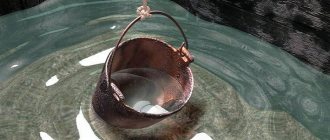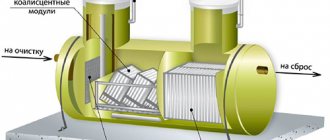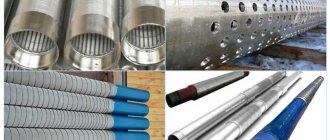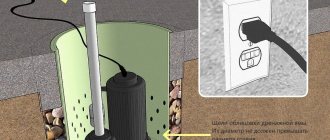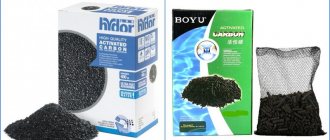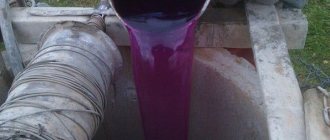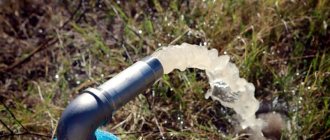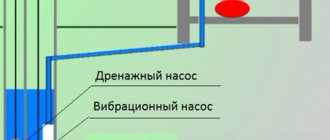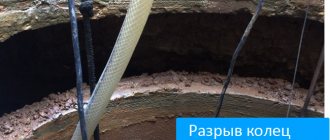19.03.2018
Well water filter: which one is right for you
Today, it is quite difficult to find absolutely clean and safe water throughout the Earth. Even such a traditional source as the site’s own well can no longer be used without additional filtration. This is most relevant in areas close to industrial zones. Therefore, manufacturers offer us a choice among several types of treatment systems designed for different contaminants. There is another option - to make a bottom filter for the well yourself, which will rid the groundwater of dangerous impurities. Next, we will tell you which filter for water from a well is more suitable for a certain level of contamination of the liquid.
From this article you will learn:
- What contaminants does a well water filter protect from?
- In what sequence to install a bottom filter for water from a well?
- Which is the best filter to buy to purify water from a well?
- How to make a filter for purifying water from a well with your own hands
How to determine the quality of well water
The ideal option is to submit the water for laboratory analysis, which will reveal its transparency, contamination with bacteria, the presence of salts, metals and other troubles. But the easiest way to determine whether water is suitable for drinking and household use is to pour it into a transparent container and see what happens to it after a couple of hours. If the transparency has not become higher, if a thick layer of sediment has formed at the bottom of the dish, if the water itself emits unpleasant odors, then you should not use it.
Of course, it is necessary to inspect the well for its integrity. Typically, cloudy water appears only if soil gets into it. Therefore, it is necessary to call repairmen who will seal the seams between the elements of the well shaft and replace the bottom filter, consisting of crushed stone.
If the color of the water is opaque, then disinfection is required. And also erect a canopy over the hydraulic structure, which will protect the well from debris, precipitation and sunlight. By the way, it is the sun that contributes to the “blooming” of water.
Muddy and clear water Source vodatyt.ru
If the water from a well is brown or yellow, then this is a sign that it contains a lot of iron salts. But here no methods other than filtering will help.
That is, it turns out that building a well is, although not an easy task, requiring certain financial investments, but it is a one-time thing. It is more difficult to organize water purification. And these are the same financial investments, only constant ones, because filtration requires constant monitoring of the cleaning efficiency. And this can only be achieved by replacing the filter elements.
But experts assure that the purity of water from a well largely depends on the technical condition of the hydraulic structure itself. Therefore, it must be repaired at least once every five years, because colonies of bacteria, which are mucus, form on the walls, the sealing of the seams between the shaft elements decreases, and the bottom filter decreases in thickness. Therefore, water is pumped out from the well, the mucus is scraped off mechanically, after which the walls of the shaft are treated with disinfectant compounds, joints are repaired, and the bottom filter is changed or supplemented.
Well cleaning and repair Source sense-life.com
The main signs and causes of water contamination in a well. What to filter water from
If the well was built in compliance with all rules and regulations, and is also operated correctly, then the water in it will meet current sanitary requirements - that is, free of impurities, foreign odors and tastes. Changes in the physical parameters of water should alert you to the following:
- Turbidity.
- Color change - black indicates decomposition of organic matter, green indicates an abundance of algae (or bloom), yellow indicates excess iron.
- The appearance of an unpleasant taste and/or odor.
- Formation of clay deposits on the walls of the well.
- Decrease in overall water level.
To understand the cause of contamination, you need to carefully inspect the well. Most often, the problem is the formation of limescale, displacement of concrete rings or their cracking, water spoilage as a result of irregular use of the source, or incorrect location of the pump. Check the clay castle - if it is destroyed or missing altogether, melt water will penetrate into the well. Also, foreign objects or animals often get into the reservoir.
Autonomous water supply diagram
Before moving on to the topic of which water filter to choose for a summer house from a well, it is necessary to explain what an autonomous water supply network is. It consists of:
- a pump with which water is supplied from the well to the house ;
- piping;
- filter systems for water purification;
- sometimes a tank in which water is collected for storage .
In such a water supply system, two types of pumping equipment are used.
Superficial
They got their name only because they are installed on the surface of the well, without being lowered into the water. A hose or plastic pipe equipped with a mesh filter is lowered into the shaft. The latter is designed to hold large undissolved particles: pebbles, organic matter, garbage, sand, etc.
Surface pump for drawing water from a well Source eka-proffiks.ru
Since the water supply system is a system with constant off-season operation, it is necessary to create all the conditions for the pump to be located in an insulated space. There are several options for this:
- inside the well , where a platform is built from metal profiles , on which the pump is installed;
- carry out the installation of a caisson , inside which a pump , part of the piping and locking fittings are mounted;
- an insulated building is erected next to the hydraulic structure , which can be used additionally for domestic needs;
- install the pump inside the house : either in a specially designated utility room , or in the basement .
Scheme of an autonomous water supply system with installation of a surface pump in the basement of a house Source www.bigam.ru
Submersible
From the name it becomes clear that this modification of water pumps is partially or completely immersed in water. That is, it is located inside the well, and a pipe is already led from the device itself directly into the house. The design of the submersible pump already includes a strainer located on the suction pipe of the unit.
These are small pumps, compact, but with a sufficiently large power that can provide water to a small country house. As for the pressure, these devices cannot boast of a large indicator. That's why they are used to pump water from shallow depths (up to 10 m), which wells have.
Installing a submersible pump in a well Source stroyportal.ru
See also: Catalog of companies that specialize in water supply and sewerage.
Does it need to be cleaned?
The reality of modern life is that even well water must be subjected to filtration systems. There are several reasons:
- Presence of nitrates.
- Presence of dangerous bacteria and microorganisms.
- Various impurities.
What bacteria/substances could there be in the mine and the reasons for their appearance?
The pollutants listed above can cause serious harm to humans. Therefore, treating your home well water is of utmost importance. The reasons why the aquifer becomes polluted can be different. The active life of farmers, the soil is saturated with large amounts of nitrates, since the fertilizers used contain pesticides and other harmful substances. Some nitrates penetrate into the aquifer.
Sanitary standards of SNIP for the construction of agricultural land, toilets, cesspools and similar structures may not be observed. As a result, dangerous bacteria penetrate into the soil.
The danger also comes down to the high sand content in the liquid; rough cleaning is required. Therefore, installing water filters in a well at the dacha is quite rational.
Advice! Having dug a well in a country house, it is recommended to take the water for samples and analyzes to the appropriate authority. Thanks to this, it is determined whether the liquid contains manganese, E. coli, dysentery and similar bacteria.
Filtration system
In this article we will not talk about the simplest water filters, which include jugs and special attachments. With their help, you can purify only slightly contaminated water that enters the house from the central water supply network. Our task is to talk about those devices that fight heavy pollution.
Coarse filter
Essentially, this is the same mesh device, only it is more advanced. That is, the mesh (metal or synthetic) is enclosed in a housing, which is cut into the piping after the pump. The main task of this type of filter is to purify water from large impurities. The particle size is determined by the size of the mesh cells.
It is this filter that retains sand, clay, small pebbles, pieces of caked lime, scale and other impurities. Most often it is made of stainless steel, in which holes are made with sizes ranging from 50 to 400 microns. The smaller the holes, the more efficiently the device works, that is, it purifies the water cleaner. Such devices have practically no limitation on their service life. They are reliable and rarely require repairs.
Coarse mesh filter Source neptun163.ru
In this regard, filter devices with polymer cartridges (usually propylene) are reliable units, but they quickly become clogged with dirt. Therefore, this group of filters is made with removable filter elements. After contamination, they are simply washed with water or replaced with new ones.
Manufacturers today offer coarse filters of different designs:
- with coupling or flange connection;
- straight or inclined;
- with or without flushing.
Obliques differ from straight ones in that the mesh element in the form of a cylinder is installed at an angle to the water flow in the former, and perpendicular to the latter. At the same time, in the design of the device there is a reservoir, which is where the mesh cylinder is installed, which additionally performs the functions of a sludge collector. That is, large particles that did not pass through the mesh settle to its bottom, and small particles of dirt settle on the latter.
Cartridge-type coarse filter with flushing Source m.yukle.mobi
Among all the known coarse filters, there are both washable and non-washable types. But cartridge models are mostly non-flushable. How do they differ from each other? Non-flushing devices are devices whose filter elements are tightly sealed into the filter housing. That is, you won’t be able to pull them out and wash them. On the contrary, flushing ones can be easily disassembled, the mesh is washed and installed in place for further use. Let us add that flushing models can only be installed on horizontal sections of pipework.
How to clean
There are several known methods:
- Reverse osmosis.
- Using ion exchange.
- Mechanical cleaning.
- Sorption filtration.
Mechanical cleaning
These contaminants are formed due to violation of the integrity of the structure, depressurization of seams, ingress of debris through the head, etc.
They are often detected visually. Mechanical cleaning is carried out first of all of the well itself and its walls. During the operation of the source, a lot of mucus is formed on the facade of the mine, which contributes to the appearance of various bacteria. Work is performed once a year if the source is used irregularly. If the fence is permanent, it is recommended to carry out cleaning more often.
The procedure for performing cleaning work:
- A submersible pump is lowered into the source to pump out water.
- Every 0.5 m, using metal brushes and softer ones, the walls are cleaned.
- Once the liquid has been completely pumped out, the bottom of the well must also be cleaned. All accumulated debris rises to the surface. Organic residues are also removed.
- If cracks are found at the joints of reinforced concrete rings, they should be thoroughly cleaned of debris and other inclusions, and then sealed hermetically.
Video description
In the video, a specialist talks about the fine filter:
Main filters
The group of pre-cleaning filters includes devices called main ones. They got their name only because they cut into the main pipe of an autonomous water supply system. This is a flask-shaped device, the body of which is made of steel or plastic. The device itself is collapsible, because a filter element is installed inside the flask.
The most important thing is that main filters easily purify water that flows through pipes at a decent speed - 20-50 l/min. At the same time, they retain not only impurities, but also chlorine, which gives the water a pleasant taste.
There are a huge variety of filters of this type on the market:
- by degree of purification;
- according to the power of water flow;
- by type of case and cartridge;
- according to the level of hydraulic losses;
- by the temperature of the liquid that flows inside the device.
The last position is important because there are filters for cold water and for hot water. The former can be used as a water filter for a garden from a well. But the latter cannot be installed with the hot water supply system at home.
Main filters in an autonomous water supply system Source blog-potolok.ru
How to choose a well water purification system
Before you start choosing a filter installation, you need to evaluate all the factors of water supply in your dacha. A liquid analysis performed in a specialized laboratory will help determine the degree of water contamination. You can estimate the availability of free space for installing the system using a measuring tape. It is easiest to calculate the amount of liquid consumed by a family in the city, where meters are installed in each apartment to monitor water consumption.
You can find out the characteristics of various filter units and the service life of the cartridges installed in them on the Internet or directly in the store. Since the water treatment system is constantly in contact with liquid consumed as food, all parts must be made of safe materials that do not emit toxic substances. If the filter is connected to the pump, it must withstand increased loads and be made of high strength materials (for example, plastic with the addition of fiberglass).
Video description
The video shows water filters as a cheap and reliable option for purifying water from iron:
Reverse Osmosis Filtration System
This is the most modern approach to filtering water from wells. Moreover, it is the most effective because it cleans by 99%. Other filters cannot boast of such indicators. In the device itself, the water goes through several degrees of purification, and the output appears as a liquid whose performance is not inferior to drinking water produced by the best manufacturers.
So, a reverse osmosis system consists of:
- preliminary water purification , where small impurities and chlorine are removed, the process itself is three-stage and is carried out in three flasks installed in series;
- Membrane-type filtration is a perforated membrane in which holes with a diameter of 0.0001 microns are made over the entire area.
The main element is the membrane. It works on an interesting principle. Water is supplied under pressure and passes through the holes into the next compartment in the form of molecules. But all known impurities cannot pass through such small holes. This is how cleaning happens. But the reverse osmosis system has one serious requirement - the filter will only work if water is supplied to the membrane under a pressure of at least 1 atm. If this is not followed, liquid will not be able to pass through the holes. But since an autonomous water supply network is primarily a pump, the water pressure inside the system can be guaranteed.
Reverse osmosis filter Source stroy-podskazka.ru
As for the three-stage pre-cleaning, the first flask is a pre-filter that allows undissolved impurities no larger than 5 microns to pass through. The second flask is a device filled with activated carbon, with which organics and chlorine are retained. And the third flask is a fine filter that retains undissolved particles with a diameter of no more than 1 micron.
A reverse osmosis filter is a rather bulky product that is usually installed in a cabinet under the sink. Today, manufacturers, trying to increase the quality of drinking water, complete the filter with a so-called mineralizer, which is filled with tourmaline balls. This mineral saturates water with sodium, magnesium and calcium.
Types of filter systems for a private home
To determine the appropriate type of cleaning device, the liquid should be analyzed for the presence of:
- Soleil;
- Gland;
- Bacteria.
Let's consider various filter options, technical characteristics, advantages, and disadvantages of each of them. Here are examples of popular models and their prices.
In what cases is a bottom one needed?
The bottom filter is suitable for use on loose clay soil with a high sand content, where the water quickly becomes cloudy. Otherwise, sand particles contained in the water will fill the filter meshes installed in the house, which will lead to overheating of the pumping equipment or breakdown.
Attention! On a dense clay bottom, installation of a bottom filter is not necessary. In such wells the water is clean because it flows through aquifers. This will only become an obstacle to filling the source.
The installation of a bottom cleaner is carried out at the stage of well construction. They create a shield from untreated oak, aspen, and maple boards. But experts do not recommend taking wood, since it very quickly begins to rot, becoming a hotbed for the development of bacteria.
It is better to use natural cleaners:
- River or quartz sand;
- Pebbles;
- Shungite;
- Gravel;
- Crushed stone;
- Porous concrete.
Laying is done in layers. The height depends on the depth of the well. Does not need frequent replacement and will last for many years. The cost depends on the selected mineral filler.
Approximate price for a three-layer filter with a volume of 60–65 kg:
- Shungite – from 5000 rubles;
- Quartz sand – from RUB 3,000;
- Small pebbles or crushed stone – from 2000 rubles.
A bottom filter is easy to make with your own hands, but it is important to understand that it only removes obvious pollutants from the liquid in the form of particles of sand and soil.
Reference. For high-quality water purification, it is recommended to combine the use of a bottom purifier with mechanical or other filters.
The best option is to install an additional complex filter. A popular Russian model is the three-stage Geyser-BIO filter. Purifies water from impurities of iron, manganese, lime, particles of heavy metals, salts. Reduces hardness and eliminates odor. The average market price is 7900 rubles.
Mechanical
Remove particles that are not dissolved in water.
There are 2 types of cleaning:
- Thin. A polymer material is wound onto the cartridges, which allows particles smaller than 5 microns to pass through. The cost of filters ranges from 200 to 1000 rubles.
- Rude. It is a mesh that traps elements measuring 5–50 microns. A budget option, but ineffective. Need frequent washing. When clogged, the water pressure decreases. Price from 100 to 500 rubles.
Modernized models of mechanical filters are produced by the Russian company.
One of them is CEPEX DF – disc wash filter. Has a large dirt holding capacity. During operation, the discs are compressed, leaving a dense mesh structure where particles of sand, soil, and clay are retained. Does not need to be replaced, but will have to be removed and washed periodically.
Disc wash filter CEPEX DF
Average price – 700 rubles. A model of a mechanical filter with automatic washing from the company will cost from 13,000 rubles.
Reference. The main purpose of mechanical filters is to protect and extend the service life of household appliances. To consume water for food, it is recommended to use additional sorption or osmotic purifiers.
Sorptive
They remove particles of heavy metals, chlorine and bacteria from water. Eliminates unpleasant odor. They make water clear and drinkable raw. Often this is a jug-shaped container with a cartridge inserted inside. The basis of the cartridge is a sorbent. The most popular is activated carbon, but may vary depending on the manufacturer.
Sorption filters are in great demand among summer residents because they are inexpensive and easy to transport . The container is filled with unpurified water and after a few minutes it can be consumed.
Filter jug BWT Penguin 2.7
According to consumers, the leader of this series of filters is considered to be the imported BWT Penguin 2.7. Copes well with heavy metals and chlorine. Convenient to wash and use. No deficiencies found. Price – 1300 rub.
More budget-friendly products from domestic companies are the Aquaphor Line jug filters (350 rubles) and Barrier Smart (600 rubles), but they cannot cope with heavy metals. Will have to wash frequently. Reviews of the Line and Smart models are available via the links.
Trunk
They have a wide range of applications, both in agriculture, industry, and in a private home or country house. They are attached to water mains, thereby preventing harmful substances from entering domestic water.
Classified by degree of purification:
- Single stage. Remove obvious impurities that are not dissolved in water. They clog quickly, so you will have to change them often.
- Two-stage. More reliable. In addition to mechanical cleaning, they also include sorption purification.
- Three-stage. They combine the functions of the first two types. In addition, they remove iron. Reduces water hardness. The highest quality filter option.
Cartridges are:
- With braided propylene;
- Winding;
- Mesh.
Main filters are used for both hot and cold water.
Based on the results of last year, Geyser Typhoon 20 BB, which has the highest degree of purification, is considered the best in this series of filters. Average price – 13,000 rubles.
Filter Geyser Typhoon 20 BB
AquaShield is considered an equally unique main filter. There is a powerful magnet inside that holds and breaks down salts. Moreover, the filter breaks down old scale, a deposit previously formed on the walls of the pipes. Excellent for hot water too. Price – about 5000 rubles. With a larger diameter, the cost will be correspondingly higher.
Geyser's direct competitor is the Aquaphor Viking main filter. Has a metal body with anti-corrosion coating. Purifies water from rust, sand particles, and pesticides. Eliminates unpleasant odor. Capable of purifying up to 25 liters of water per minute. Price – 8000 rub. Read reviews about the model on the Otzovik website.
Flow-through
Available in two types:
- Nozzles;
- Under the sink.
Their installation and operation require powerful pumps with high pressure in the system.
Let's look at each of them in more detail.
Faucet or hose attachments
Filters are attached to the tap or water supply hose. Provides a maximum of two-stage cleaning: mechanical, sorption.
Produced in 2 variations:
- Permanent. Attached to a faucet or hose. One nozzle can purify from 500 to 2000 liters of water.
- Removable. Dress as needed. To obtain purified drinking water.
Interesting! On average, one nozzle can produce from 0.2 to 6 liters of water in 1 minute.
A significant disadvantage of nozzles is the slowdown of the application system. Therefore, if the water supply comes from a deep well, it is not recommended to use nozzles. There is a high probability of overheating and rapid equipment breakdown.
Filter attachment – New Water T5
There are models on sale that do not interfere with the stable operation of the water supply system. Among them is the filter attachment – New Water T5. Suitable for hot, cold water. Cleanses away obvious contaminants. Yellow water, saturated with iron elements, makes it transparent. Has 3 degrees of purification. Price – 2700 rub.
A cheap option is the Barrier Comfort model. The filter attachment is removable type. If necessary, it can be easily screwed to the sink faucet or shower. Removes rust and reduces water hardness. But it slows down the deposition a little. Price – 1150 rub.
Under the sink
This type of filter does not threaten the operation of the pumping system, since it processes water very quickly. Has up to 4 degrees of purification.
The inside of the cartridge is filled with activated carbon. Thoroughly cleans the liquid from harmful impurities . But this advantage turns into a disadvantage after a while. A cartridge clogged with sand or silt becomes a breeding ground for the development of many bacteria. It is necessary to strictly monitor the timely replacement of the cartridge.
An excellent option is the product New Water Expert M312. Has 4 degrees of purification. The set includes a faucet for clean water. In addition to activated carbon, the cartridge contains silver ions, which provide maximum cleaning. The output water is close to bottled. Price – 5,947 rub. Read reviews about the model at the link.
New water Expert M312
For summer cottages where the water contains a high concentration of iron, a domestic filter - EXPERT Ferrum Barrier - is well suited. Eliminates unpleasant odor. Effectively copes with rust. Turns water from yellow to clear. Price – 3,790 rub.
Reverse osmacy
Another name is membrane filters. It is recommended to install in areas located near industrial enterprises and factories. Filters with a reverse osmosis system purify the liquid to a distilled state .
Important! The basis of the device is a membrane with many holes that allows only the smallest water molecules to pass through. This prevents heavy metals, salts, and bacteria from getting into your drink.
To prevent the membrane from becoming clogged quickly, experts advise installing additional filters with cartridges based on polypropylene or activated carbon. Due to this, water that has undergone several degrees of purification is supplied to the membrane device.
A significant disadvantage is the large volume of water transmission . To get 5 liters of purified water, the product processes 40 liters, that is, the main part is wasted. And in the private sector, where the sewage system is a cesspool, it will have to be pumped out much more often.
It is believed that reverse osmosis systems over-purify the water, which is why it turns out dead, devoid of any useful elements. But filter models are available for sale that can not only purify water by 99.9% of harmful impurities, but also saturate it with oxygen and beneficial minerals in safe quantities.
A striking example is the Atoll A-550 MAX filter. The volume of the clean water tank is 12 l. When boiling, scale does not form on the walls of the cookware. The only negative is that you will have to separately purchase a tap for clean water. Price – 16,700 rubles. Reviews can be found on the Yandex Market website.
Filter Atoll A-550 MAX
A competing model from another manufacturer is the New Water Expert Osmos MO530 filter.
Cleanses from:
- Petroleum products;
- Pesticides, herbicides;
- Chlorine;
- Organic compounds;
- Radioactive elements;
- Salts and heavy metals.
Eliminates odors. Reduces water hardness, due to which scale does not form when heated. The system operates almost silently. Price – 11970 rub.
Ion exchange
In other words - water softeners. The products are responsible for reducing hardness - the content of calcium, magnesium, and other alkaline earth metal salts in water. The state regulates the requirements for water hardness - SanPiN 2.1.4.1074-01. The norm is considered to be up to 7 mEq/l.
Hard water tastes bitter. When boiling it leaves a white coating on the walls. Constant use in food leads to the development of diseases of the gastrointestinal tract, joints and more.
The service life of household appliances, plumbing and heating systems is reduced. A filter based on ion exchange will solve this problem.
Water passes through the ion exchange resin, particles of calcium, magnesium, iron are retained in it, and in return the liquid is enriched with sodium ions.
It has a plastic or steel body, inside of which there is a capsule with resins. A significant advantage is the recovery of the ion exchange resin . You can do this at home by rinsing with a solution of kitchen salt.
More expensive models have multiprocessor control, so recovery occurs automatically.
The Cascade-Comfort-0.5 automatic model is considered an eternal ion exchange filter. Excellent for permanent use in the private sector. Produces from 0.5 cu. m of purified water per hour.
Ion exchange filter Cascade-Comfort
The guaranteed service life is 10 years . The cartridge does not require replacement. Cost – 78,000 rubles. Imported analogues will cost even more. For budget summer residents, such an expensive purchase is impractical. It is easier and cheaper to install a mechanical and sorption filter at the same time.
Reviews about the use of ion exchange filters can be read on the ForumHouse website.
Complex options
Does not need replacement. They work fully automatically.
Cleaned from the following impurities:
- Gland;
- Manganese;
- Ammonium;
- Heavy metals;
- Reduce stiffness;
- Organic compounds.
Consists of 3 main parts:
- Loading container. Material: high-strength plastic.
- Control valve. Installed on top of the cylinder. Fully regulates the cleaning process, restoring the filter if necessary. Has a built-in water meter. It is thanks to this element that human control over the device is excluded.
- Salt tank. Necessary for flushing the filter system.
Based on functionality, complex systems are divided into 3 classes:
- Standard. They purify water from organic compounds, metals, chlorine, and hydrogen sulfide. Eliminates odor and cloudy color. Reduces hardness. Budget model – Column EMS X starting at RUB 37,500.
- Premium In addition to the above functions, the systems are equipped with automatic control in Russian and protective heat-insulating linings. Example – ECOSOFT FK 1054 TWIN. Price – 103,000 rub.
- Elite. The systems are designed for areas with high water pollution. Works well with iron and petroleum products. This is the Ecomaster DOUBLET model from Ecodar, costing 118,000 rubles.
A complex filtration system is an expensive pleasure
A comprehensive filtration system is an expensive proposition . The purchase is only possible for owners of large country estates with an unlimited budget. For owners of dachas and small private sectors, you should pay attention to main-line, flow-through or mechanical filters in combination with a bottom cleaner.
Important! It should be remembered that the filter is selected strictly individually, based on the composition of the water and the required volume of liquid for cleaning.
How to make it yourself
Let's look at several technologies for making a homemade filter for a home well. In particular, several simple methods are known:
- Three-bulb.
- Carbonic.
- From coal and moss.
Three-bulb
An ideal solution when a pipeline enters a private house. You can do it yourself as follows:
- You should take 3 flasks.
- They must be connected to each other using nipples. A special tape is used to seal the joint.
- The side holes are connected by straight adapters to the tube.
- At the next stage, the product is connected to the existing water supply through tees.
- A tap for water intake is installed at the outlet of the flask.
- Finally, the flasks are filled with filter material.
Effective cleaning methods
If the results of the study show that the fears are not groundless and the water contains impurities hazardous to health, the situation should be corrected as quickly as possible.
The choice of method depends on the cause of contamination. If debris has accumulated inside the structure and mucus has formed on the walls, it is worth using a mechanical method when cleaning the structure.
Mechanical cleaning of the mine
The method involves cleaning the walls and bottom of a hydraulic structure by washing or scraping off accumulated deposits. Mechanical cleaning is best done in late summer or early spring before the snow melts. During the off-season, the groundwater level is at its lowest.
Accumulated sludge and mucus should be cleaned regularly, as they are ideal conditions for the growth of bacteria, which release toxic substances during their life.
The mechanical cleaning procedure includes several main steps:
- Pumping out water. Before performing mechanical cleaning, the structure is first emptied by pumping out the liquid with a drainage pump. Keep in mind that it will not be possible to completely drain the well shaft; a small amount of water will still remain at the bottom.
- Cleaning the walls and bottom. The cleaning worker, wearing a protective suit, lowers himself into the well. The assistant remains on the surface and takes the filled buckets. Debris and sludge residues are removed manually using a metal brush or a regular scraper. The crushed stone and sand that covers the bottom of the structure and serves as a bottom filter are replaced with new ones.
- Repair and strengthening of well rings. If necessary, to prevent the rings from moving relative to each other, they are reinforced with metal brackets.
- Sealing of seams. If cracks are detected in the seams between the rings, the defects are repaired with cement mortar to which liquid glass has been added.
When replacing the bottom filter, instead of crushed stone, you can use natural sorbents such as shungite or zeolite. They not only mineralize water, but also protect it well from heavy metals and petroleum products. The thickness of the newly laid layer must be at least 15 cm.
Regardless of the depth of the mine, when cleaning it, it is important to follow safety precautions: work with a partner and use a safety rope.
Treatment of well walls with chlorine
- Upon completion of cleaning the well using the mechanical method, a pre-prepared disinfection solution is distributed onto the walls and roof.
Before disinfection, it is necessary to clean the walls of the well from plaque.
- To prepare the solution, you need to dissolve bleach (20 mg) in a liter of water, then close the container in which the composition was prepared with a lid to prevent chlorine from evaporating. After some time, the mixture is poured into a separate container, and the sediment is disposed of.
Preparing a bleach solution
- The surfaces of the well are treated with the prepared solution using a spray bottle or brush. It is recommended to do this three times at intervals of two hours.
Well disinfection
- To disinfect water, a chlorine solution is used: 150 g of lime per cubic meter of water. The mixture is added directly to the well. You can use a long stick for mixing.
The solution (in this case, potassium permanganate) is poured into the well
- To achieve a homogeneous mixture of water and chlorine, you can use a bucket. To do this, after adding chlorine to the well, you will need to scoop up water with a bucket and vigorously drain it back. This action must be repeated for 10 minutes. While the well is being disinfected, water cannot be taken from it for consumption. Even boiling will not make the water usable in this case.
- Then the well must be tightly covered with a lid so that the chlorine does not evaporate, and left for six hours to settle the water. After which the specific smell of chlorine will disappear. Then prepare a new solution of chlorine (4 times less lime for the same amount of water) and dilute it with well water. This time it is enough to wait 4 hours.
At the end, the well must be covered with a lid.
Attention! After disinfecting water using this method, it should not be consumed until the chlorine odor is completely eliminated. And then for another 7 days the water will need to be boiled before cooking or drinking.
Care must be taken when working with chlorine solution. The reagent vapors are poisonous, so you should protect your respiratory system with a respirator. Contact of the mixture with the skin can cause a chemical burn, to prevent which rubber workwear is used when working with chlorine. You can use welding goggles to protect your eyes.
The first obvious signs of chlorine poisoning are: sharp chest pain, dry cough, vomiting, pain in the eyes (lacrimation)
Carrying out disinfection work
Water disinfection is carried out after mechanical cleaning is completed and leaks in the joints are eliminated. It is performed by applying the solution to the walls of the structure with a fur roller or a wide brush. For this purpose, bleach is used.
To prepare a 2% solution, bleach is diluted with water at the rate of 20 g of powder per 1 liter of liquid. When using pure chlorine, a solution of the required concentration is obtained by diluting the powder at the rate of 3-5 g per 1 liter of water.
To prepare a disinfectant solution, use enamel or glass containers, first pouring cold water into the container, and then adding chlorine or lime.
The prepared solution is infused for 1-2 hours in a container with a tightly closed lid. The settled mixture is poured into another container. The top layer that rises to the surface is used for disinfection.
Disinfection of a well using chlorine is performed in the following sequence:
- A diluted 2% solution is applied to the inner walls of the well using a wide brush or roller, covering them evenly over the entire surface. The remainder of the preparation is treated with the bottom filter.
- After applying the product, the well is filled with water. A new portion of the solution is added to the poured water, but prepared in a ratio of 1:5.
- The solution poured into the well is thoroughly mixed with a long pole or by alternately scooping up the liquid with a bucket and then pouring it back.
- The neck of the treated and filled with water well is covered with a lid with plastic film and left for a day. This is necessary because chlorine tends to evaporate quickly. For chlorine to have the desired effect, it is important to keep the mine cool.
- After waiting 24 hours, chlorinated water is pumped out of the well and waiting for it to fill. The next day, the disinfection procedure is repeated.
An average of 500 g of solution is required per cubic meter.
The required amount of solution for water disinfection is calculated on the basis that the volume of one ring 90 cm high with a diameter of 1 meter is 700 liters.
Water that has been purified cannot be used. Before putting the structure into operation, the well will have to be drained and wait until it is filled from scratch. If there is a smell of chlorine in the water after filling, you will have to repeat the procedure. Within 5-7 days after completion of chlorination, the water is boiled.
If we consider other available means, then disinfection of the structure can also be performed using the same potassium permanganate. To do this, potassium permanganate is diluted in water at the rate of 1 teaspoon of powder per 10 liters of liquid. The solution is poured into a mine with water.
After waiting a day, they empty the well and wait until it is filled again. After cleaning is completed, a small bag made of synthetic fabric and filled with potassium permanganate is lowered into the shaft. It should be left in the well permanently.
There are also special chlorine-containing preparations such as “Aquatabs”, “Septolite-DHC”, “Ecobreeze-Oxy” on sale. They are available in liquid, powder or tablet form.
Based on these concentrates, disinfectant solutions are diluted in accordance with the instructions, which are used using the same technology as when working with bleach. Any of these means improves water quality and extends the life of the structure.
Application of dosing cartridges
In case of severe water contamination, when simple cleaning methods do not give the desired result, experts recommend using more radical measures - using dosing cartridges.
Dosing cartridges are ceramic small cylindrical containers, inside of which a mixture based on bleach and calcium hydrochloride is placed.
The body of cartridges with a volume of 250 to 1000 cm3 is made of ceramic, the porous walls of which freely allow active chlorine to pass into the water. The number of cartridges required for disinfection depends on the volume of water in the mine and the degree of its contamination.
Disinfection using dosing cartridges should be carried out under the guidance of SES workers, while monitoring the quality of water in relation to microbiological and sanitary-chemical indicators.
The containers are suspended into the well shaft, immersed in the water column and placed at a height of 20 to 50 cm from the surface of the bottom filter. The concentration of the active substance in water is monitored 6 hours after the cartridge is immersed. It should be 0.5 mg/l. If the indicators are lower than required, another cartridge is buried.
In the future, concentration monitoring is performed every seven days. Cartridges are replaced every 3-4 weeks.
Electrochemical purification method
Electrochemical cleaning methods are technologically simple and do not require the use of reagents. The disadvantage that reduces the prevalence of the method is energy costs.
The essence of the method is the passage of liquid through the interelectrode space, where electrolysis, electrophoresis and removal of dissolved substances occur.
There are varieties of the electrochemical method:
- Electrolysis.
- Electroflotation.
- Electrodialysis.
- Electrocoagulation.
Alternative method of ultraviolet cleaning
The contents of a well can also be disinfected by irradiating it with ultraviolet light. This method is less labor-intensive, but more expensive. Disinfection with ultraviolet light is performed only after preliminary mechanical cleaning.
The unit is a disinfection chamber, inside of which there is an ultraviolet lamp equipped with a protective coating.
UV rays, the wavelength range of which is 200-295 Nm, are capable of destroying pathogenic microorganisms. The higher the radiation dose, the less time is required to disinfect the mine contents. A radiation dose of 15 mJ/cm² is sufficient to destroy most pathogenic bacteria.
The main advantage of water purification by ultraviolet irradiation is that it does not change the taste of drinking water.
